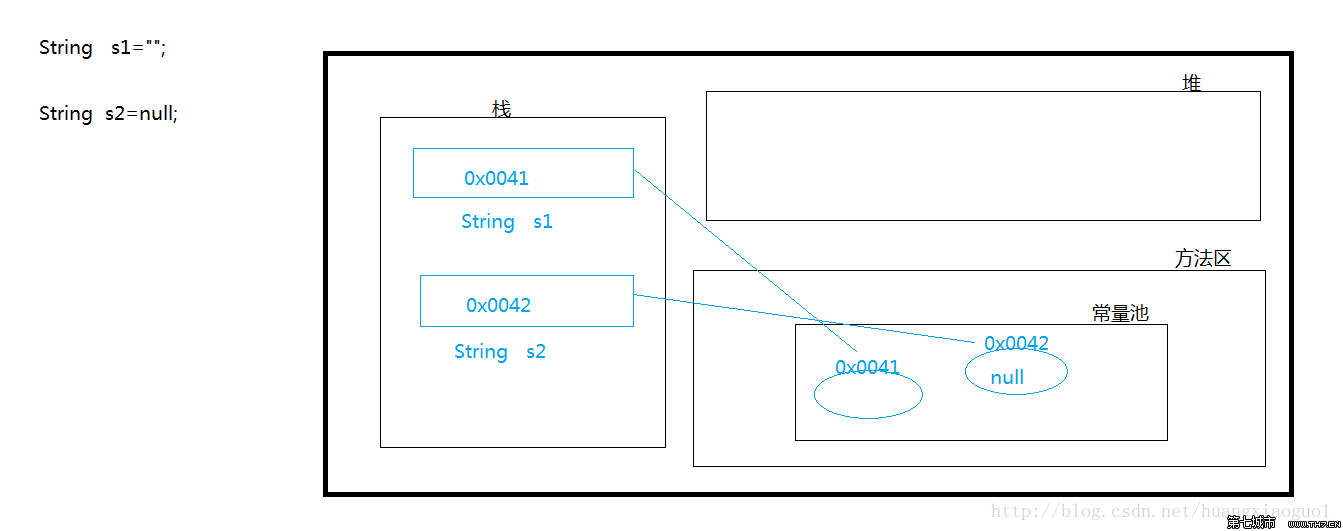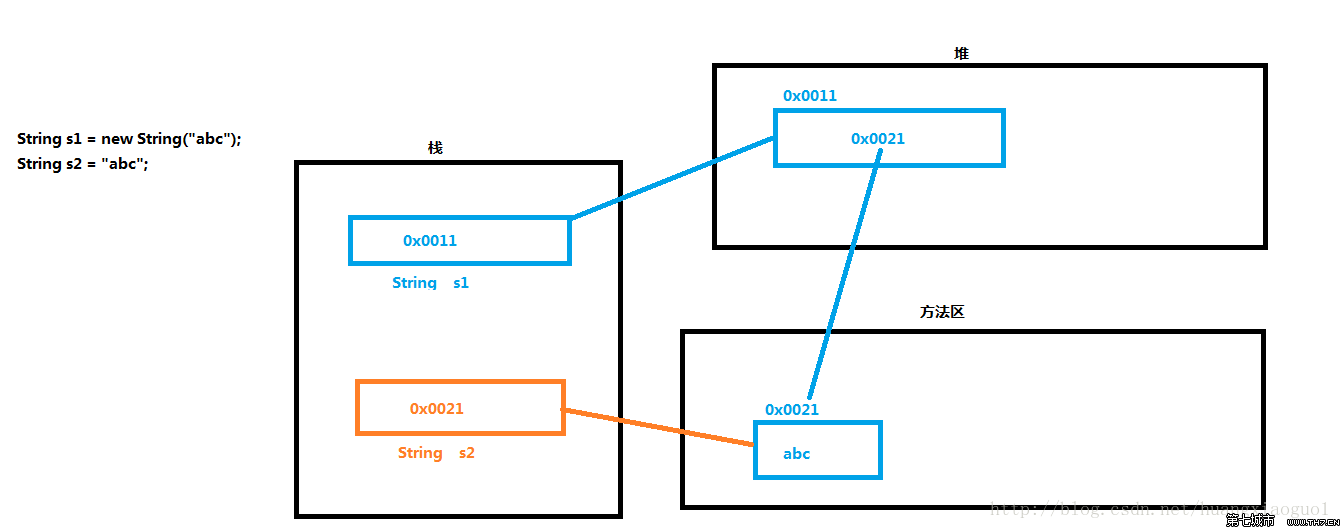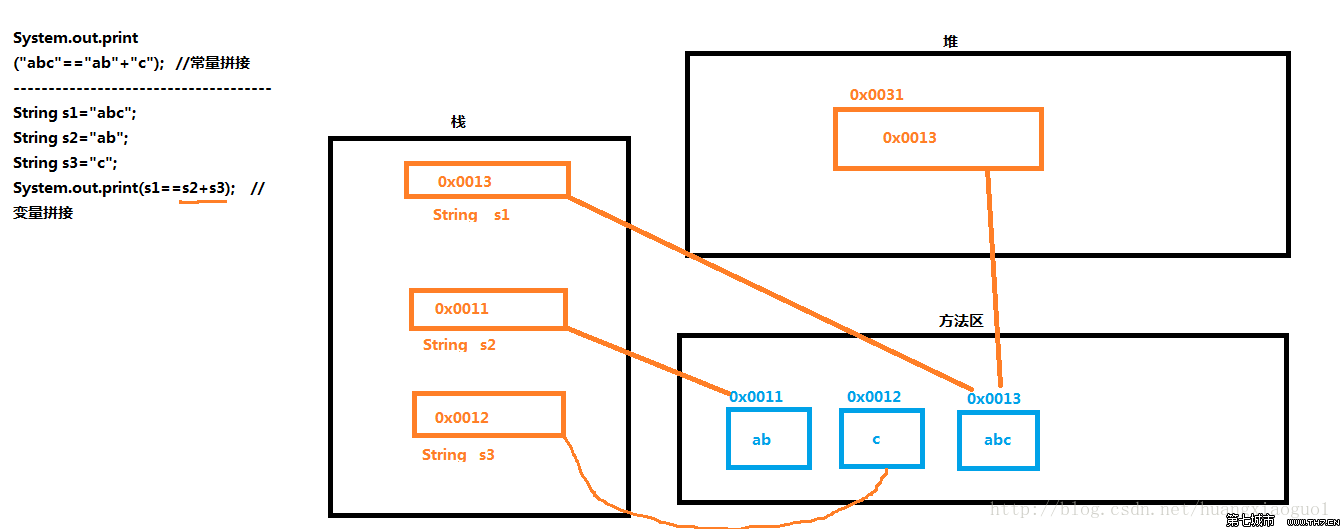 Java
Java
 javaTutorial
javaTutorial
 Regaining the basics of Java (12): Summary of the most commonly used type of Java: String
Regaining the basics of Java (12): Summary of the most commonly used type of Java: String
Regaining the basics of Java (12): Summary of the most commonly used type of Java: String
Regain the basics of java (12): Summary of the most commonly used type of String in java
1. Overview of the String class
-
Character char One character '' String String One or more ""
2. String is a reference data type and belongs to the java.lang package
3. Coding table ascii unicode
4. Java language supports unicode
2. Construction method
空构造 public String()
String s1=new String();
System.out.println(s1);
输出结果为空。
参数为字符串
public String(String s)
String s2=new String("hello"); //String s2="hello";
System.out.println(s2);
输出结果为 hello
参数为字节数组
public String( byte[] bytes ) 转换
byte[] t={97,98,99,'d'}; //byte b='d';
String s3=new String(t);
System.out.println(s3);
输出结果为 abcd 它是将byte数组类型转化为ASCII
表对应的字符
参数为字符数组 public String( char[] value ) 转换
char[] c={'a','b','c',100}; //char d=100;
String s4=new String(c);
System.out.println(s4);
输出结果为 abcd 它是将char数组类型转化为ASCII
表对应的字符。3. String is Memory allocation map of a special reference type
1. 它支持两种写法:
String s="hello"; //s也是对象
String s=new String("hello");
注意:
String s1="hello";String s2="hello";这时有三个对象
s1、s2、hello2. 画内存分配图new String

Memory allocation in two ways: new and non-new

Empty

3. A string constant can be used directly as an object

4. +
Splicing strings can only splice strings
2. If When a string is spliced with a non-string, Java will automatically convert the non-string into a string, and then splice it
3. Note: the memory when using + to splice strings Allocation diagram (String objects are immutable)

4. Even if the String object is not new, then string splicing is performed New memory space is opened in the heap every time
5. When string constants are spliced, new memory space is not opened in the heap (emphasis)
5. Methods for determining function-related issues
boolean equals(Object obj)
String s1="hello";
String s2=new String("HellO");
System.out.println(s1==s2);
System.out.println(s1.equals(s2));
输出结果为 false false ;
equals比较的是内容区分大小写boolean equalsIgnoreCase(String str)String s3="hello";
String s4="Hello";System.out.println(s3==s4);
System.out.println(s3.equalsIgnoreCase(s4));
輸出結果為 false true ;
equalsIgnoreCase比较的是内容不区分大小写boolean contains(String str)String s1="hello";
System.out.println(s1.contains("ho"));输出结果为 false 这个方法是看“hello”中是否包含ho
记得不能分开,如果是he的话结果就是 trueboolean startsWith(String str)System.out.println(s1.startsWith("he"));
输出结果是:true
这个方法是求输入的这个字符串是否
以你定义的这个字符串开头的!
这里就是看 “hello”是否以he开头
如果换成e 结果就为false了。
boolean endsWith(String str)
System.out.println(s1.endsWith("llo"));
输出结果为:true 这个方法是求输入的这个字符串是否
以你定义的这个字符串结尾的!
这里就是看 “hello”是否以lo结尾
如果换位ll 结果就为false了。boolean isEmpty() "" null
s1="";System.out.println(s1.isEmpty());
输出结果为:true 这个方法是看 s1这个字符串是否为""
如果是就为true
注意:null1.null在Java中是作为常量存在的2.它表示对象不存在3.一个是可以作为初始值来用,一个是可以加快垃圾回收的速度6. Methods for obtaining function-related functions
int length()
String s1="heloool";System.out.println(s1.length());
输出结果为:7
这个方法是来求一个字符串的长度的。
char charAt(int index)
System.out.println(s1.charAt(0));
输出结果为 h 这个方法是用来输入字符串的某个字符的地址坐标来
输出这个坐标所对应的值;如果输入2的话输出应该为l。
int indexOf(int ch) 和int indexOf(String str);
System.out.println(s1.indexOf("he"));
输出结果为 0 这个方法是用来寻找输入的字符串(例如he)在当前字
符串(heloool)中首次出现的,首个字符的位置。
注意he要连写,并且不能为ho这种形式 他们都会
输出 -1
int indexOf(int ch,int fromIndex)和int indexOf(String str,int fromIndex)
System.out.println(s1.indexOf("l",4));
输出结果为 6 这个方法是用来寻找输入的字符串(例如l)在当前字
符串(heloool)中你定义的从哪个地址坐标(4)开始
出现的,首个字符的位置。
String substring(int start)和
String substring(int start,int end)
////
String substring(int start)
System.out.println(s1.substring(3));
输出结果为:oool 这个方法是为了求出 s1这个字符串中 从3开始
包括(3)这个坐标,开始输出字符串,一直到结尾。
//
String substring(int start,int end)
System.out.println(s1.substring(2,5));
输出结果为 loo 这个方法是为了求出 s1这个字符串中 从2开始
包括(2)这个坐标,开始输出字符串,一直到5(不包括5
这个坐标)。
注意:java有两个原则 一、就近原则;二、顾前不顾后原则。7. Methods for converting function-related functions
byte[] getBytes()
String s1="abcde";
byte[] b=s1.getBytes();
for (int i = 0; i < b.length; i++) {
System.out.println(b[i]);}输出结果为:97 98 99 100 101(竖着写)
这个方法表示将一个String 类型的字符串转化为:byte
类型的数组;对应的值为ASCII表值。
char[] toCharArray()
char[] c=s1.toCharArray();
for (int i = 0; i < c.length; i++) {
System.out.println(c[i]);}输出结果为:a b c d e (竖着写)这个方法表示将一个字符转变为数组 。
注意 数组类型为charstatic String valueOf(char[] chs) //相当于 new String(char[] c)
String s2=String.valueOf(c);
System.out.println(s2);输出结果为:abcde
这个方法是将c这个数组转化为字符串
static String valueOf(基本数据类型 i)
int j=100;
s2=String.valueOf(j); //s2=j+"";
System.out.println(s2+100); 输出结果为:100100 这个方法是将基本数据类型转化为字符串。
注意 : 我们一般将基本数据类型转化为字符串类型一般用
s2=j+"";String toLowerCase()
String s3="hElLo";
System.out.println(s3.toLowerCase());输出结果为:hello
这个方法是将字符串统一为小写形式。
String toUpperCase()System.out.println(s3.toUpperCase());输出结果为:HELLO
这个方法是将字符串统一为大写形式。
String concat(String str) “+”
String s4=s3.concat(",world");
System.out.println(s4);
输出结果为:hElLo,world
这个方法是将字符串进行拼接。8. Other functions of the String class
替换String replace(String old,String new)
String s1="helloe";
s1=s1.replace("l", "123");
System.out.println(s1);输出结果为:he123123oe
这个方法是将字符串中的l全部用123来替换。分割
String[] split(String regex)
String s2="abcdeffcdtt";
String[] ss=s2.split("cd");
for (int i = 0; i < ss.length; i++) {
System.out.println(ss[i]);
}输出结果为:ab eff tt(竖着写)
这个方法是从cd分割,且不要cd 其前与后都
分别存入数组。
去除字符串两端的空格
String trim()
String s3=" he llo world ";
s3=s3.trim();
System.out.println(s3);输出结果为:he llo world
这个方法是将s3字符串两端的空格去掉!
s3=s3.replace(" ", "");
System.out.println(s3); 输出结果为:helloworld
注意: 用""来替换" " 这样就起到了删除效果补充:
int lastIndexOf(int ch)int lastIndexOf(int ch,int fromIndex)int lastIndexOf(String s)
String s4="hello";
System.out.println(s4.indexOf("l")); //输出为2 这个是从前向后找
System.out.println(s4.lastIndexOf("l")); //输出为3 这个是从后向前找!
int lastIndexOf(String s,int fromIndex)The above is a summary of the basics of Java (12): the most commonly used type of String in Java. For more related content, please pay attention to PHP Chinese Net (www.php.cn)!

Hot AI Tools

Undresser.AI Undress
AI-powered app for creating realistic nude photos

AI Clothes Remover
Online AI tool for removing clothes from photos.

Undress AI Tool
Undress images for free

Clothoff.io
AI clothes remover

AI Hentai Generator
Generate AI Hentai for free.

Hot Article

Hot Tools

Notepad++7.3.1
Easy-to-use and free code editor

SublimeText3 Chinese version
Chinese version, very easy to use

Zend Studio 13.0.1
Powerful PHP integrated development environment

Dreamweaver CS6
Visual web development tools

SublimeText3 Mac version
God-level code editing software (SublimeText3)

Hot Topics
 1385
1385
 52
52
 Perfect Number in Java
Aug 30, 2024 pm 04:28 PM
Perfect Number in Java
Aug 30, 2024 pm 04:28 PM
Guide to Perfect Number in Java. Here we discuss the Definition, How to check Perfect number in Java?, examples with code implementation.
 Weka in Java
Aug 30, 2024 pm 04:28 PM
Weka in Java
Aug 30, 2024 pm 04:28 PM
Guide to Weka in Java. Here we discuss the Introduction, how to use weka java, the type of platform, and advantages with examples.
 Smith Number in Java
Aug 30, 2024 pm 04:28 PM
Smith Number in Java
Aug 30, 2024 pm 04:28 PM
Guide to Smith Number in Java. Here we discuss the Definition, How to check smith number in Java? example with code implementation.
 Java Spring Interview Questions
Aug 30, 2024 pm 04:29 PM
Java Spring Interview Questions
Aug 30, 2024 pm 04:29 PM
In this article, we have kept the most asked Java Spring Interview Questions with their detailed answers. So that you can crack the interview.
 Break or return from Java 8 stream forEach?
Feb 07, 2025 pm 12:09 PM
Break or return from Java 8 stream forEach?
Feb 07, 2025 pm 12:09 PM
Java 8 introduces the Stream API, providing a powerful and expressive way to process data collections. However, a common question when using Stream is: How to break or return from a forEach operation? Traditional loops allow for early interruption or return, but Stream's forEach method does not directly support this method. This article will explain the reasons and explore alternative methods for implementing premature termination in Stream processing systems. Further reading: Java Stream API improvements Understand Stream forEach The forEach method is a terminal operation that performs one operation on each element in the Stream. Its design intention is
 TimeStamp to Date in Java
Aug 30, 2024 pm 04:28 PM
TimeStamp to Date in Java
Aug 30, 2024 pm 04:28 PM
Guide to TimeStamp to Date in Java. Here we also discuss the introduction and how to convert timestamp to date in java along with examples.
 Java Program to Find the Volume of Capsule
Feb 07, 2025 am 11:37 AM
Java Program to Find the Volume of Capsule
Feb 07, 2025 am 11:37 AM
Capsules are three-dimensional geometric figures, composed of a cylinder and a hemisphere at both ends. The volume of the capsule can be calculated by adding the volume of the cylinder and the volume of the hemisphere at both ends. This tutorial will discuss how to calculate the volume of a given capsule in Java using different methods. Capsule volume formula The formula for capsule volume is as follows: Capsule volume = Cylindrical volume Volume Two hemisphere volume in, r: The radius of the hemisphere. h: The height of the cylinder (excluding the hemisphere). Example 1 enter Radius = 5 units Height = 10 units Output Volume = 1570.8 cubic units explain Calculate volume using formula: Volume = π × r2 × h (4
 How to Run Your First Spring Boot Application in Spring Tool Suite?
Feb 07, 2025 pm 12:11 PM
How to Run Your First Spring Boot Application in Spring Tool Suite?
Feb 07, 2025 pm 12:11 PM
Spring Boot simplifies the creation of robust, scalable, and production-ready Java applications, revolutionizing Java development. Its "convention over configuration" approach, inherent to the Spring ecosystem, minimizes manual setup, allo





